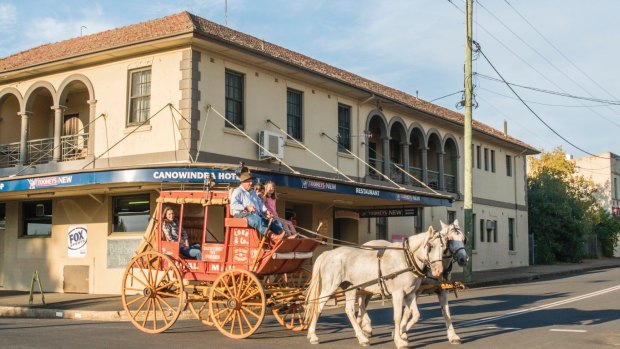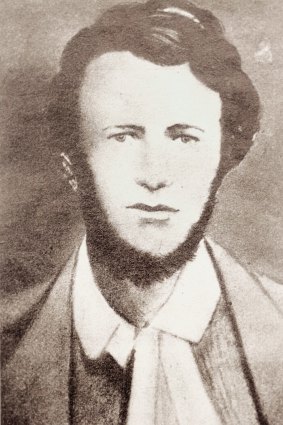This was published 5 years ago
Canowindra, NSW, bushranger tour: The other town held hostage by bushrangers
By Steve Meacham

A stage coach ride through Canowindra streets. Credit: Destination NSW
Ned Kelly's raid across the NSW/Victoria border in 1879 to hold hostage the entire town of Jerilderie is one of the most famous acts in Australian political/criminal history.
Posing as constables after catching the police station unawares, locking the police in their own cells and stealing their uniforms, the Kelly gang gathered the entire population in the pub.
Money wasn't the main objective. Ned dictated his "Jerilderie Letter" to Joe Byrne – the one literate member of his gang – planning for his "republican manifesto" to be printed by Samuel Gill, editor of the local newspaper. Gill – absent on the day – missed the one international scoop of his life, though the 56-page letter spawned Peter Carey's novel, True History of the Kelly Gang.

Ben Hall circa 1865.Credit: National Library of Australia
And yet, says Craig Lawler, Jerilderie wasn't the first town to be held to ransom by bushrangers who stole police uniforms to add to the subterfuge.
That dubious honour goes to Canowindra (pronounced Can-nown-dra), 300 kilometres west of Sydney, between Cowra and Orange.
Lawler greets me in Canowindra's historic Gaskill Street, and frankly I'm scared.
He's big, burly and so bushy-bearded I expect to be bailed-up at any minute.
Journalist, teacher and aspiring author, Lawler founded Blind Freddy's bushranger tours of the NSW Central West, pledging it would be built on historical research, not romantic myth.
And, he points out, 17 years before the Jerilderie incident, another famous NSW bushranger gang pioneered the tactics.Though Ben Hall is usually portrayed as the leader of the three-day Canowindra lock-up in October 1863, he was still a foot soldier.
The gang's original leader, Frank Gardiner, had masterminded the biggest gold heist in Australian history at Eugowra (35 kilometres north-west of Canowindra) in 1862, but had quit while he was ahead. (Gardiner died in California, owning a pub.)
Then "Flash Johnny" Gilbert took command. Four others were in his gang: John O'Meilly, Mickey Burke, Johnny Vane and Hall, Lawler explains, as we walk over "the swinging bridge" to the other side of the flood-prone Belubula River.
The Traveller's Rest, was one of two pubs, either side of the river, both owned by the Robinson family. The hotel, on the high side of the river was simply known as Robinson's.
The Eugowra heist marked the finale of the classic bushranger era, Lawler says. And what killed the trade was something as innocuous as the postal order and the "half-note" (notes were cut in half and sent in two individual shipments, only becoming legal tender when they were reunited at the receiving bank).
Bailing up a stage coach when there's no money aboard isn't exactly a business plan. Worse, 1863 was one of the wettest years on record.
Though Flash Johnny's gang was famed for its sartorial splendour (their clothes stolen from victims) no thief looks good in soaking wet apparel.
And no alert bushranger would light a campfire to dry clothes since that would alert the lawmen, led by Sir Frederick Pottinger – one of the most complex men in Australia's complex colonial history.
So Gilbert came up with a new plan. The gang started robbing squatter homesteads in the NSW Central Tablelands. Often all they wanted, Lawler says, was a dry roof over their heads and a decent feed.
Canowindra, then little more than a few houses on a hill overlooking a river crossing on the route between Sydney and the gold mines of modern-day Forbes, was raided four times by the gang in 1863/4.
Each time, Robinson's Hotel was the target. No-one was killed, raped or physically abused. But each time, the town's only shopkeeper, Mr Pearce, was robbed.The first raid took place in September 1863.
"They'd stolen three police uniforms and used them to good effect," Lawler explains.
Old man Robinson was away, so Robinson's was left in the charge of his wife and daughters. The three dressed as constables were admitted to the pub allowing the other two to enter, revealing their true intent," Lawler says. "Nothing untoward took place, apart from dancing, feasting and drinking. The gang left the next morning, after robbing Pearce of blankets."
A month later the gang returned. With the rain still pelting down, Hall and Vane swam over the swollen Belubula to the Traveller's Rest. There they discovered Superintendent Chatfield – the police chief charged with preventing Canowindra being attacked again by bushrangers – had left that very day, leaving only the hapless Constable Sykes in charge.
After robbing Pearce of more blankets, the gang rode out of town.
Then they realised, with the rivers "up", they were on an island protected by a single policeman – so they rode back and commandeered the entire town.
Their three-day lock-in made news around the English-speaking world, thanks to the new-fangled telegraph.You'll need to take one of Lawler's tours to discover the full story.
Suffice to say, it didn't end well for any of the bushrangers.
TRIP NOTES
Steve Meacham travelled as a guest of Central NSW Tourism.
MORE
traveller.com.au/new-south-wales
visitnsw.com/Discover/Canowindra
TOUR
Blind Freddy's Bushranger Tours: blindfreddytours.com
EAT
Canowindra Trading Post: canowindratrading.post.com.au
Sign up for the Traveller Deals newsletter
Get exclusive travel deals delivered straight to your inbox. Sign up now.